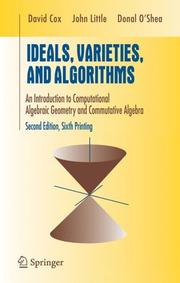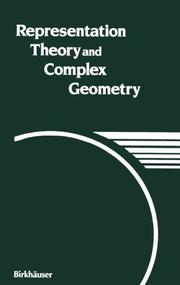| Listing 1 - 5 of 5 |
Sort by
|
Book
ISBN: 2842250036 9782842250034 Year: 1997 Volume: 2 Publisher: Paris : Cassini,
Abstract | Keywords | Export | Availability | Bookmark
 Loading...
Loading...Choose an application
- Reference Manager
- EndNote
- RefWorks (Direct export to RefWorks)
Géométrie algèbrique --- Géométrie --- Actions de groupes (mathématiques). --- Problèmes et exercices. --- Etude et enseignement (supérieur). --- Géométrie algèbrique --- Géométrie --- Actions de groupes (mathématiques). --- Problèmes et exercices. --- Etude et enseignement (supérieur). --- Géométrie algébrique --- Actions de groupes (mathématiques)
Book
ISSN: 12723835 ISBN: 2856290558 9782856290552 Year: 1997 Volume: 5 Publisher: Paris : Société Mathématique de France - SMF,
Abstract | Keywords | Export | Availability | Bookmark
 Loading...
Loading...Choose an application
- Reference Manager
- EndNote
- RefWorks (Direct export to RefWorks)
Quantum groups. --- Knot theory. --- Categories (Mathematics) --- Three-manifolds (Topology) --- Hopf algebras --- Hopf, Algèbres de --- Hopf, Algèbres de. --- Quantum groups --- Groupes quantiques. --- Géométrie algébrique --- Lie, Algèbres de --- Hopf algebras. --- Géométrie algébrique --- Hopf, Algèbres de --- Lie, Algèbres de --- Catégories (mathématiques)

ISBN: 0387946802 1475726953 1475726937 9780387946801 Year: 1997 Publisher: New York : Springer,
Abstract | Keywords | Export | Availability | Bookmark
 Loading...
Loading...Choose an application
- Reference Manager
- EndNote
- RefWorks (Direct export to RefWorks)
Algebraic Geometry is the study of systems of polynomial equations in one or more variables, asking such questions as: Does the system have finitely many solutions, and if so how can one find them? And if there are infinitely many solutions, how can they be described and manipulated? The solutions of a system of polynomial equations form a geometric object called a variety; the corresponding algebraic object is an ideal. There is a close relationship between ideals and varieties which reveals the intimate link between algebra and geometry. Written at a level appropriate to undergraduates, this book covers such topics as the Hilbert Basis Theorem, the Nullstellensatz, invariant theory, projective geometry, and dimension theory. The algorithms to answer questions such as those posed above are an important part of algebraic geometry. This book bases its discussion of algorithms on a generalization of the division algorithm for polynomials in one variable that was only discovered in the 1960's. Although the algorithmic roots of algebraic geometry are old, the computational aspects were neglected earlier in this century. This has changed in recent years, and new algorithms, coupled with the power of fast computers, have let to some interesting applications, for example in robotics and in geometric theorem proving. In preparing a new edition of Ideals, Varieties and Algorithms the authors present an improved proof of the Buchberger Criterion as well as a proof of Bezout's Theorem. Appendix C contains a new section on Axiom and an update about Maple , Mathematica and REDUCE.
Geometry, Algebraic --- Commutative algebra --- Data processing --- Algebraic geometry --- Algèbres commutatives --- Géométrie algébrique --- Algèbres commutatives --- Géométrie algébrique --- Computer. Automation --- Informatique --- Mathematical logic. --- Mathematical Logic and Foundations. --- Algebra of logic --- Logic, Universal --- Mathematical logic --- Symbolic and mathematical logic --- Symbolic logic --- Mathematics --- Algebra, Abstract --- Metamathematics --- Set theory --- Syllogism --- Geometry, Algebraic - Data processing --- Commutative algebra - Data processing --- Géométrie algébrique. --- Algorithms --- Algorithmes. --- Algèbres commutatives.

ISBN: 0817637923 9780817649425 9780817649371 9780817637927 Year: 1997 Publisher: Boston Birkhäuser
Abstract | Keywords | Export | Availability | Bookmark
 Loading...
Loading...Choose an application
- Reference Manager
- EndNote
- RefWorks (Direct export to RefWorks)
This volume is an attempt to provide an overview of some of the recent advances in representation theory from a geometric standpoint. A geometrically-oriented treatment is very timely and has long been desired, especially since the discovery of D-modules in the early '80s and the quiver approach to quantum groups in the early '90s.
Group theory --- Algebraic geometry --- Differential geometry. Global analysis --- Ordered algebraic structures --- Géométrie différentielle --- Géométrie algébrique --- Représentations de groupes --- Variétés symplectiques --- Geometry, Differential --- Symplectic manifolds --- Representations of groups --- Geometry, Algebraic --- 514.1 --- 514.1 General geometry --- General geometry --- Manifolds, Symplectic --- Manifolds (Mathematics) --- Group representation (Mathematics) --- Groups, Representation theory of --- Differential geometry --- Geometry

ISBN: 0817640002 9780817640002 3764340002 1461273781 1461220084 Year: 1997 Volume: 150 Publisher: Boston ; Basel ; Berlin : Birkhäuser,
Abstract | Keywords | Export | Availability | Bookmark
 Loading...
Loading...Choose an application
- Reference Manager
- EndNote
- RefWorks (Direct export to RefWorks)
Real analytic sets in Euclidean space (Le. , sets defined locally at each point of Euclidean space by the vanishing of an analytic function) were first investigated in the 1950's by H. Cartan [Car], H. Whitney [WI-3], F. Bruhat [W-B] and others. Their approach was to derive information about real analytic sets from properties of their complexifications. After some basic geometrical and topological facts were established, however, the study of real analytic sets stagnated. This contrasted the rapid develop ment of complex analytic geometry which followed the groundbreaking work of the early 1950's. Certain pathologies in the real case contributed to this failure to progress. For example, the closure of -or the connected components of-a constructible set (Le. , a locally finite union of differ ences of real analytic sets) need not be constructible (e. g. , R - {O} and 3 2 2 { (x, y, z) E R : x = zy2, x + y2 -=I- O}, respectively). Responding to this in the 1960's, R. Thorn [Thl], S. Lojasiewicz [LI,2] and others undertook the study of a larger class of sets, the semianalytic sets, which are the sets defined locally at each point of Euclidean space by a finite number of ana lytic function equalities and inequalities. They established that semianalytic sets admit Whitney stratifications and triangulations, and using these tools they clarified the local topological structure of these sets. For example, they showed that the closure and the connected components of a semianalytic set are semianalytic.
Differential geometry. Global analysis --- Semialgebraic sets --- Semianalytic sets --- Topology. --- Algebraic geometry. --- Algebraic topology. --- Mathematical logic. --- Geometry. --- Algebraic Geometry. --- Algebraic Topology. --- Mathematical Logic and Foundations. --- Mathematics --- Euclid's Elements --- Algebra of logic --- Logic, Universal --- Mathematical logic --- Symbolic and mathematical logic --- Symbolic logic --- Algebra, Abstract --- Metamathematics --- Set theory --- Syllogism --- Topology --- Algebraic geometry --- Geometry --- Analysis situs --- Position analysis --- Rubber-sheet geometry --- Polyhedra --- Algebras, Linear --- Semianalytic sets. --- Semialgebraic sets. --- Geometry, Algebraic --- Semi-analytic sets --- Géométrie algébrique --- Géométrie algébrique --- Espaces analytiques
| Listing 1 - 5 of 5 |
Sort by
|

 Search
Search Feedback
Feedback About
About Help
Help News
News